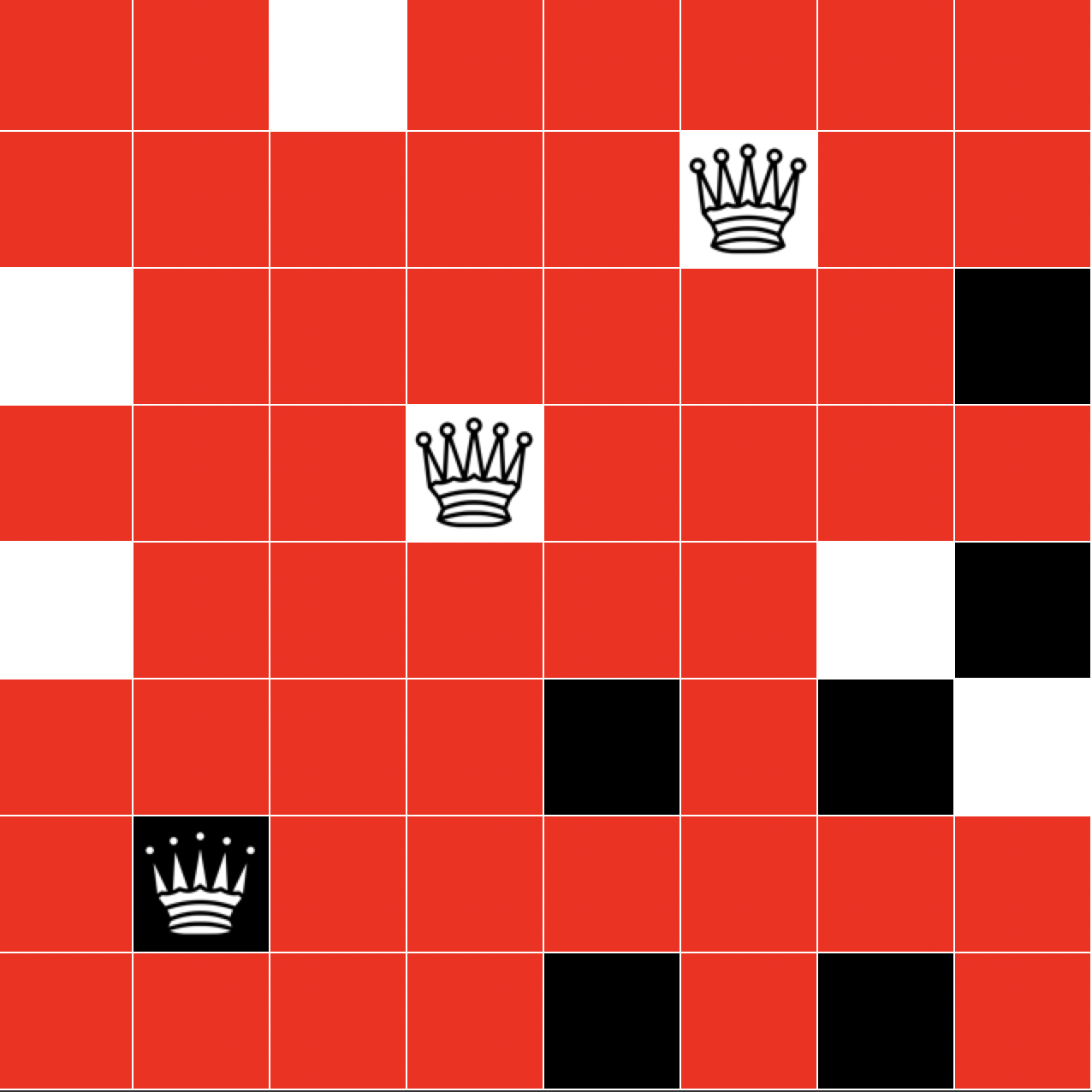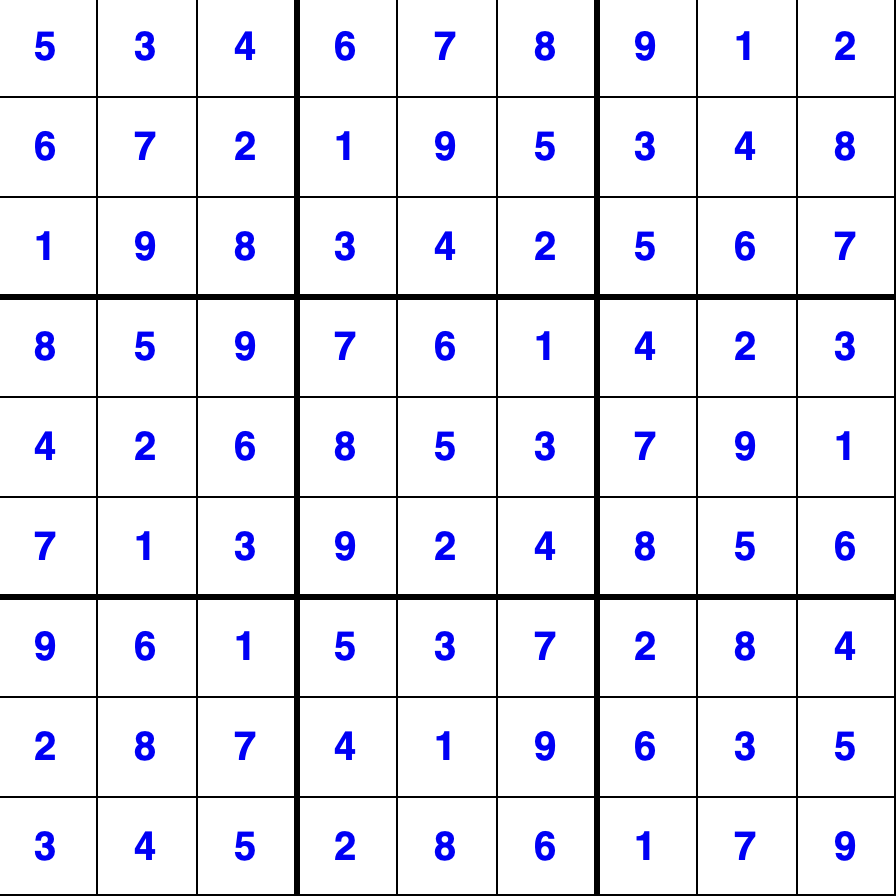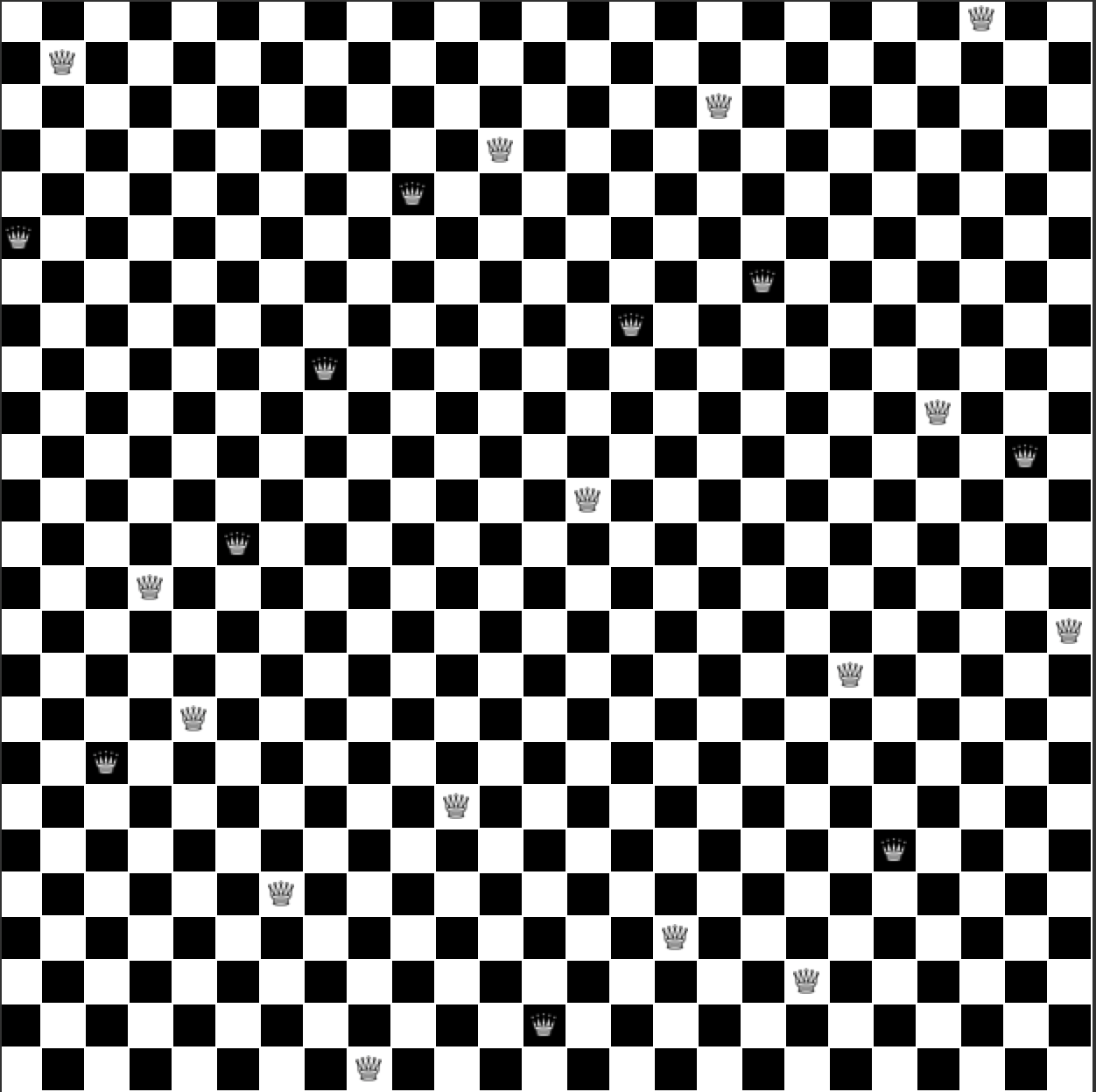Constraints Satisfaction Problems
Assignement on solving the NQueen using backtracking

Introduction
In this assignment, you’ll explore how Constraint Satisfaction Problems (CSPs) can be applied to the classic N-Queens problem — a challenge of placing N queens on an N×N chessboard so that none attack each other.
You will implement and evaluate two fundamental approaches:
- Backtracking Search: A depth-first strategy that places queens row by row while ensuring the board remains valid.
- Local Search with Min-Conflicts: A heuristic method that starts with a complete assignment and iteratively resolves conflicts until a solution emerges.
- Sudoku Solver with Forward Checking: You’ll implement a CSP-based solver that fills in Sudoku puzzles by looking ahead and pruning invalid choices before they’re made.
By the end, you’ll not only solidify your understanding of CSPs and heuristics, but also visualize how these algorithms behave in real time.
Can queens find harmony on the board? That’s your mission. 👑
Here is the Starter code for this project.
Question 1 — Valid Board Check (4 pts)
Before solving the N-Queens problem, we need a way to verify whether a given board configuration is valid — that is, no two queens are attacking each other.
In this question, your task is to implement the function is_valid(queens) located in the cps.py file.
The function should return True if the current queen positions do not conflict (no queens share the same column, row, or diagonal), and False otherwise.
You’ll be working with a dictionary where the keys are row indices and the values are column positions of queens. For example:
queens = {
0: 1,
1: 3,
2: 0,
3: 2
}
This represents 4 queens placed on a 4×4 board.
✅ Your Task
- Open the file:
cps.py - Locate the function:
is_valid(queens) - Complete the implementation so it correctly checks for conflicts.
To Test Your Code
We’ve provided a test file with unit tests for this function.
To run only the tests related to is_valid, use the following command:
pytest -m is_valid
✔️ Make sure your implementation passes all test cases before moving on.
Question 2 — Backtracking Search (6 pts)
One of the classical approaches to solving the N-Queens problem is using backtracking search. This algorithm attempts to place queens on the board row by row, choosing one column at a time, and backtracks whenever a placement leads to an invalid configuration.
The idea is simple:
- For each row, try placing a queen in every column.
- After placing a queen, check if the board remains valid (i.e., no queens attacking each other).
- If valid, move to the next row.
- If no valid column exists for the current row, backtrack to the previous one and try a different placement.
This process continues recursively until all queens are successfully placed, or no solution is found.
Your Task
Implement the function backtracking(board, row=0) in the file csp.py. This function should:
- Try placing one queen per row.
- Use the
is_valid()method from Question 1 to ensure validity. - Use recursion to proceed row by row.
- Use backtracking when a dead-end is reached.
Board Methods Available
The board object passed into your function is an instance of the ChessBoard class. You can use the following methods:
| Method | Description |
|---|---|
board.place_queen(row, col) | Place a queen at (row, col) |
board.remove_queen(row, col) | Remove a queen from (row, col) |
board.root.update() | Important: Refreshes the board view |
⚠️ Attention: You must call
board.root.update()after placing or removing a queen to visualize the changes on the board.
To Test Your Code
To test your implementation on a board of size n (e.g., 8), use the following command:
python run_solver.py 8 backtracking
This will visually show your backtracking algorithm solving the N-Queens problem on an 8×8 board. You can change the size to any value you like (e.g., 4, 10, 12).
Question 3 _ Forward checking I
To enhance the efficiency of solving the N-Queens problem, we now move to a constraint propagation technique called forward checking.
What Is Forward Checking?
Instead of blindly placing queens and then checking validity, forward checking proactively eliminates choices by identifying which squares are no longer available after placing a queen.
To do this, we must compute — at any point in the algorithm — which squares are forbidden (i.e., they are attacked by at least one existing queen).
✅ Your Task
Implement the function get_forbidden_squares(queens, board_size) in the file csp.py.
Function Signature:
def get_forbidden_squares(queens, board_size):
...
Parameters:
-
queens: a dictionary of{row: col}where each queen is currently placed. -
board_size: the size of the board (N).
Returns:
- A set of
(row, col)tuples representing all squares that are under attack by any queen currently on the board.
Reminder:
A square is considered forbidden if it shares:
- The same column with another queen.
- The same diagonal (positive or negative slope) with another queen.
- The same row is automatically excluded by design (we place one queen per row).
To Test Your Code
We’ve included a dedicated test suite for this function. Once implemented, run the following command to test only this part:
python test_forbidden.py

Question 4 — Forward Checking II (6 pts)
Now that you’ve implemented get_forbidden_squares(), you’re ready to build a smarter N-Queens solver using forward checking.
What Will Your Algorithm Do?
Unlike simple backtracking, this version will:
- Place one queen per row (as before),
- But before placing the next queen,
- It will use
get_forbidden_squares()to identify all attacked positions, - And only consider valid (non-forbidden) positions for the next row,
- It will use
- If no valid columns are left in the next row, it backtracks.
This form of constraint propagation helps prune the search space early — making the algorithm significantly faster and more efficient.
Your Task
Implement the function forward_search(board, row=0) in the file csp.py.
Requirements:
- Use
get_forbidden_squares()to determine the current forbidden positions. - Only attempt placements in columns that are not forbidden.
- Recursively move to the next row if a queen is placed successfully.
- Backtrack if a dead-end is reached.
Board Methods Available
As with backtracking, you can use:
| Method | Description |
|---|---|
board.place_queen(row, col) | Place a queen at (row, col) |
board.remove_queen(row, col) | Remove a queen from (row, col) |
board.clear_not_possible() | Clear red markers |
board.mark_not_possible(r,c) | Mark (r,c) as a forbidden (red) square |
board.root.update() | Refreshes the view (call after updates) |
⚠️ Important: Use
board.root.update()to visualize each step andmark_not_possible()to highlight forbidden squares on the board.
To Test Your Implementation
Run the following command to launch your visual solver with forward checking:
python run_solver.py 8 forward_search
You should see:
- Queens being placed row by row,
- Forbidden squares marked in red after each move,
- And a full solution visualized when successful.
🎯 Try experimenting with larger board sizes (e.g., 12, 16) to see how forward checking improves performance.
Question 5 — Solving Sudoku with Forward Checking (10 pts)
Sudoku is another Constraint Satisfaction Problem (CSP) where we must assign numbers to a 9×9 grid while ensuring that:
- Each row contains digits 1-9 exactly once.
- Each column contains digits 1-9 exactly once.
- Each 3×3 block contains digits 1-9 exactly once.
In this question, you will complete a Sudoku solver using Forward Checking by implementing two key functions.
Your Task
You are given a partially implemented Sudoku solver. The GUI, board setup, and visualization methods have been provided. However, you must complete the two most important CSP methods:
1️⃣ get_possible_values(board, row, col)
This function should return a set of valid numbers that can be placed at (row, col) without violating Sudoku constraints.
Implementation Details:
- A number is valid if it doesn’t already appear in:
- The same row.
- The same column.
- The 3×3 block the cell belongs to.
Function Signature (in soduko_solver.py):
def get_possible_values(board, row, col):
...
Example Usage:
valid_numbers = get_possible_values(board, 2, 4)
print(valid_numbers) # Output: {1, 3, 5, 6, 9} (depends on board state)
solve_with_forward_checking(board)
This function should implement Sudoku solving using Forward Checking:
- Find the next empty cell (row, col).
- Use
get_possible_values()to determine valid numbers for that position. - Try placing a valid number, then recursively solve the rest of the board.
- Backtrack if needed when no valid numbers remain.
🔧 Function Signature (in soduko_solver.py):
def solve_with_forward_checking(board):
...
What’s Already Provided?
You do not need to worry about:
- The Sudoku board visualization (it’s already coded).
- The GUI updates (handled automatically).
- The Sudoku grid setup (a test puzzle is included).
Your focus is only on implementing these two methods.
To Test Your Code
Once implemented, run the following command to test your solver:
python sudoku_solver.py

- First, you will see the original puzzle.
- After 3 seconds, the board should fill in the solution if your functions are correct.
- If the solution is incorrect or doesn’t appear, debug your
get_possible_values()function.
Hints
- To extract all numbers in a row:
board[row] - To extract all numbers in a column:
[board[r][col] for r in range(9)] - To find the 3×3 block’s starting row/col, use:
start_row, start_col = 3 * (row // 3), 3 * (col // 3)
🚀 Challenge: Try solving a 16×16 Sudoku (instead of 9×9) by modifying the board size!
Question 6 — Local Search (Min-Conflicts Heuristic) (10 pts)
To wrap up the assignment, you’ll implement a local search strategy for solving the N-Queens problem using the powerful Min-Conflicts heuristic.
This approach is particularly effective for high-dimensional boards (N > 100), where traditional backtracking or forward checking would struggle.
Local search starts with a complete but possibly invalid assignment — placing one queen per row, even if there are conflicts. Then, it repeatedly improves the solution by:
- Selecting a queen that’s in conflict.
- Moving it within its row to the column that causes the fewest conflicts.
- Repeating this process until the board is conflict-free or a max number of steps is reached.
This is known as the Min-Conflicts Algorithm.
It’s fast, efficient, and surprisingly effective — even for large boards like 1000×1000.
You will implement the following three functions in the file csp.py.
1️⃣ count_conflicts(queens, row, col)
This function returns the number of queens that would be attacking a queen if it were placed at position (row, col).
Hints:
- Count queens already placed in the same column or on the same diagonal.
- Do not count the queen in the same row (since only one queen per row is placed).
2️⃣ get_conflicted_rows(queens)
Returns a list of all row indices where the queen is currently in conflict with another queen.
This helps us identify which queen to move during each iteration of local search.
3️⃣ min_conflicts(board, max_steps=1000)
The main solver. It should:
- Start with a random initial placement (1 queen per row).
- For up to
max_steps, do:- Pick a row with a conflicted queen.
- Move the queen in that row to the column with the fewest conflicts.
- Update the board visually using
board.place_queen(...)andboard.remove_queen(...).
If a solution is found (no conflicts remain), return True.
If max_steps is reached and conflicts still exist, return False.
To Test Your Implementation
Try running your local search algorithm on a large board to see how fast it performs:
python run_solver.py 100 min_conflicts
You should see a solution computed quickly — even for 100×100 boards!
Try increasing N to 200, 500, or even 1000 to explore the scalability of local search.

🚀 Bonus Challenge (No Extra Points)
- Add a random restart if a solution isn’t found after
max_steps. - Track and display the number of steps taken or conflicts resolved.